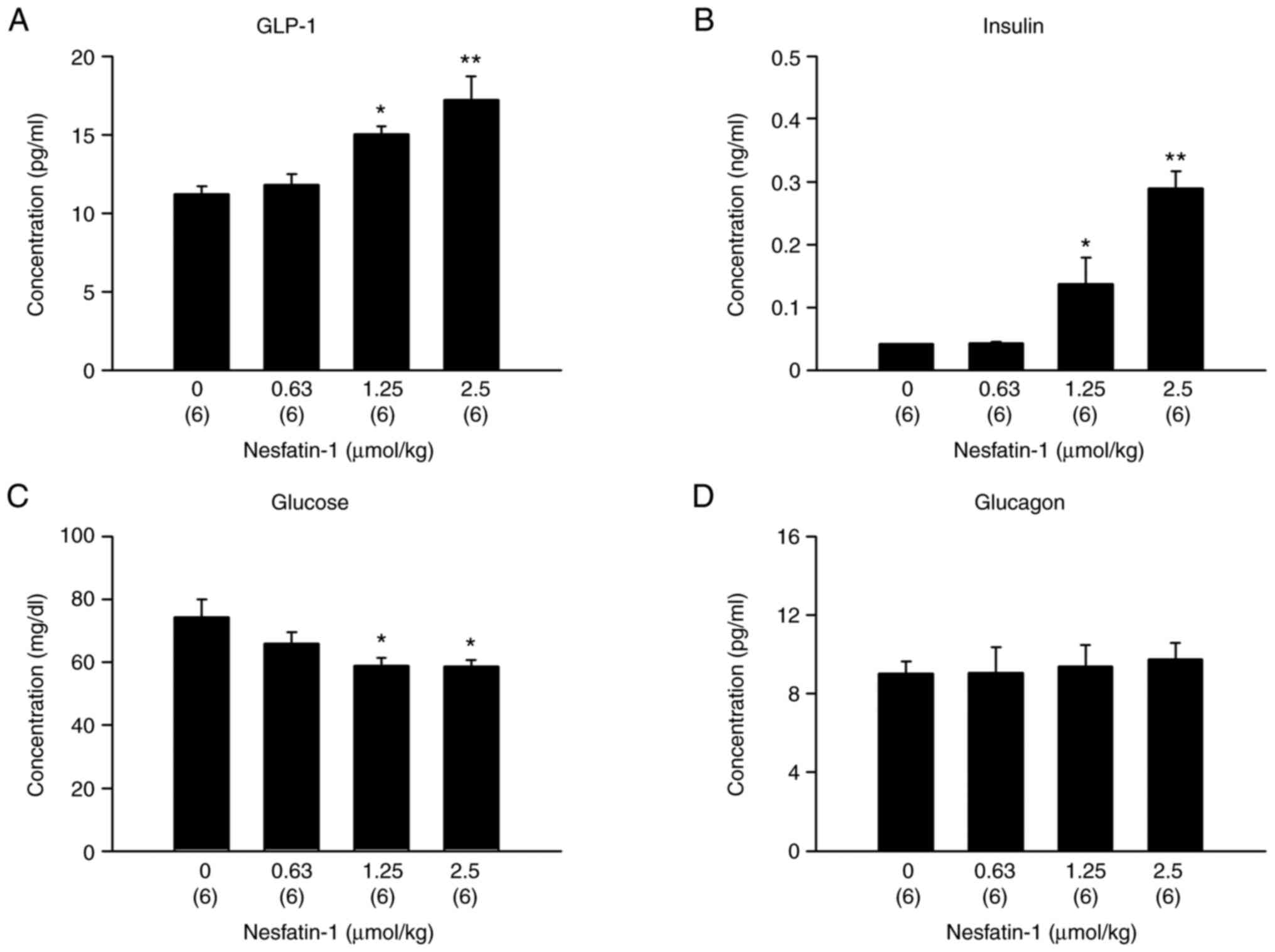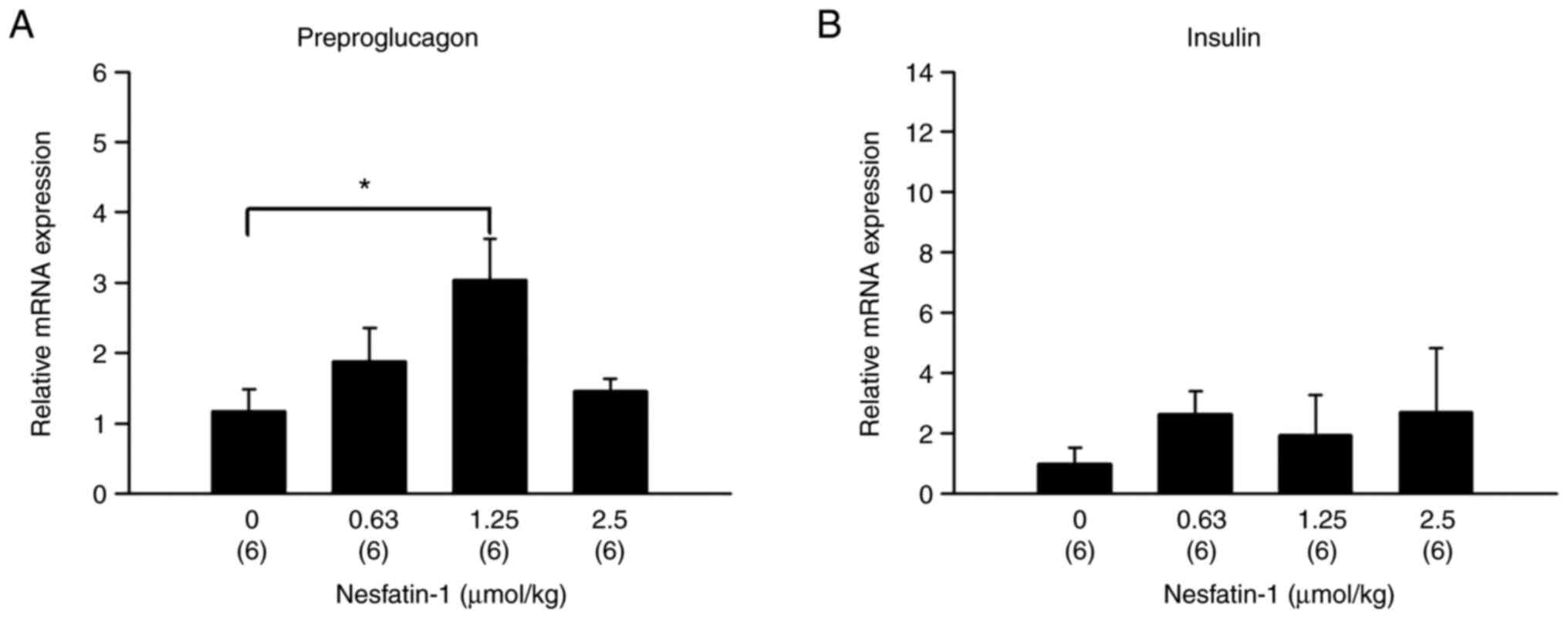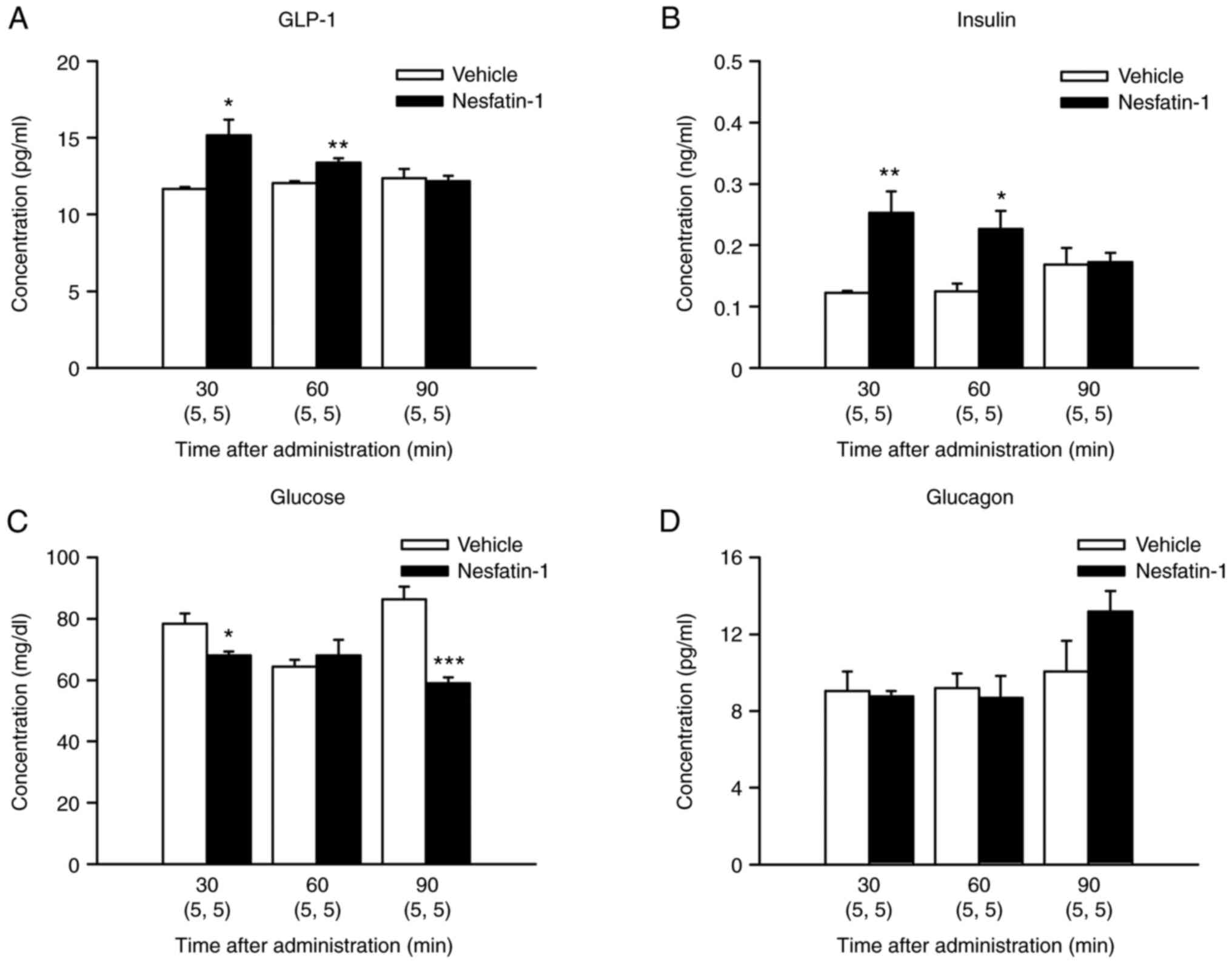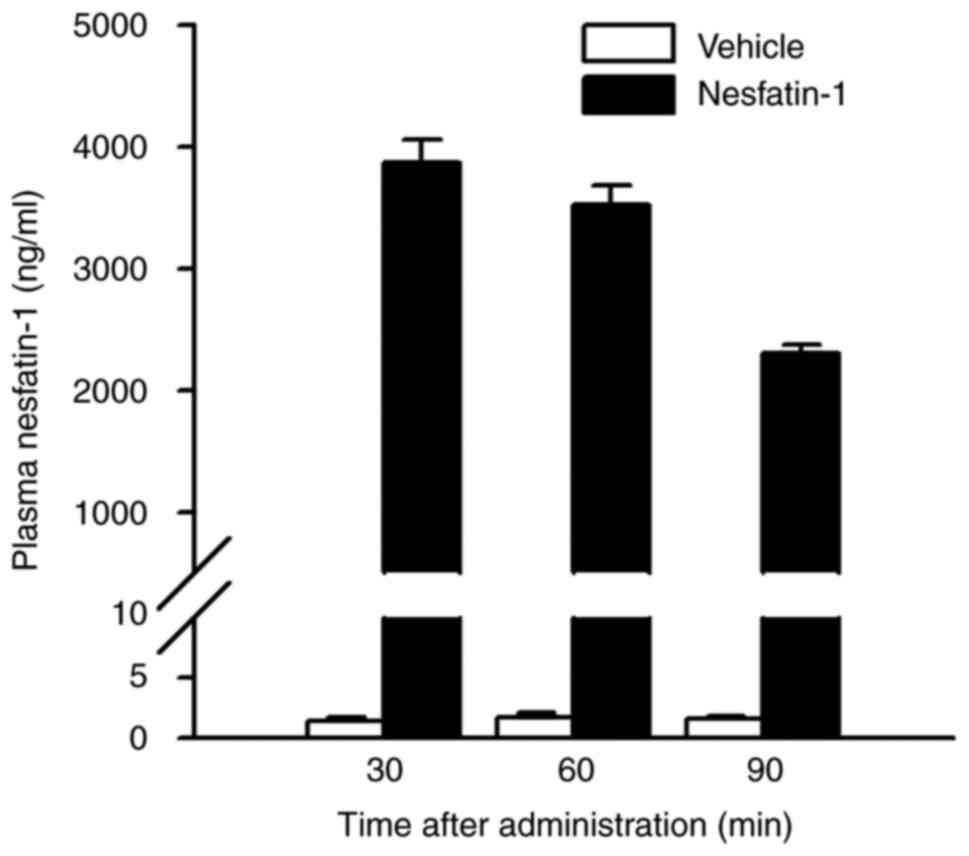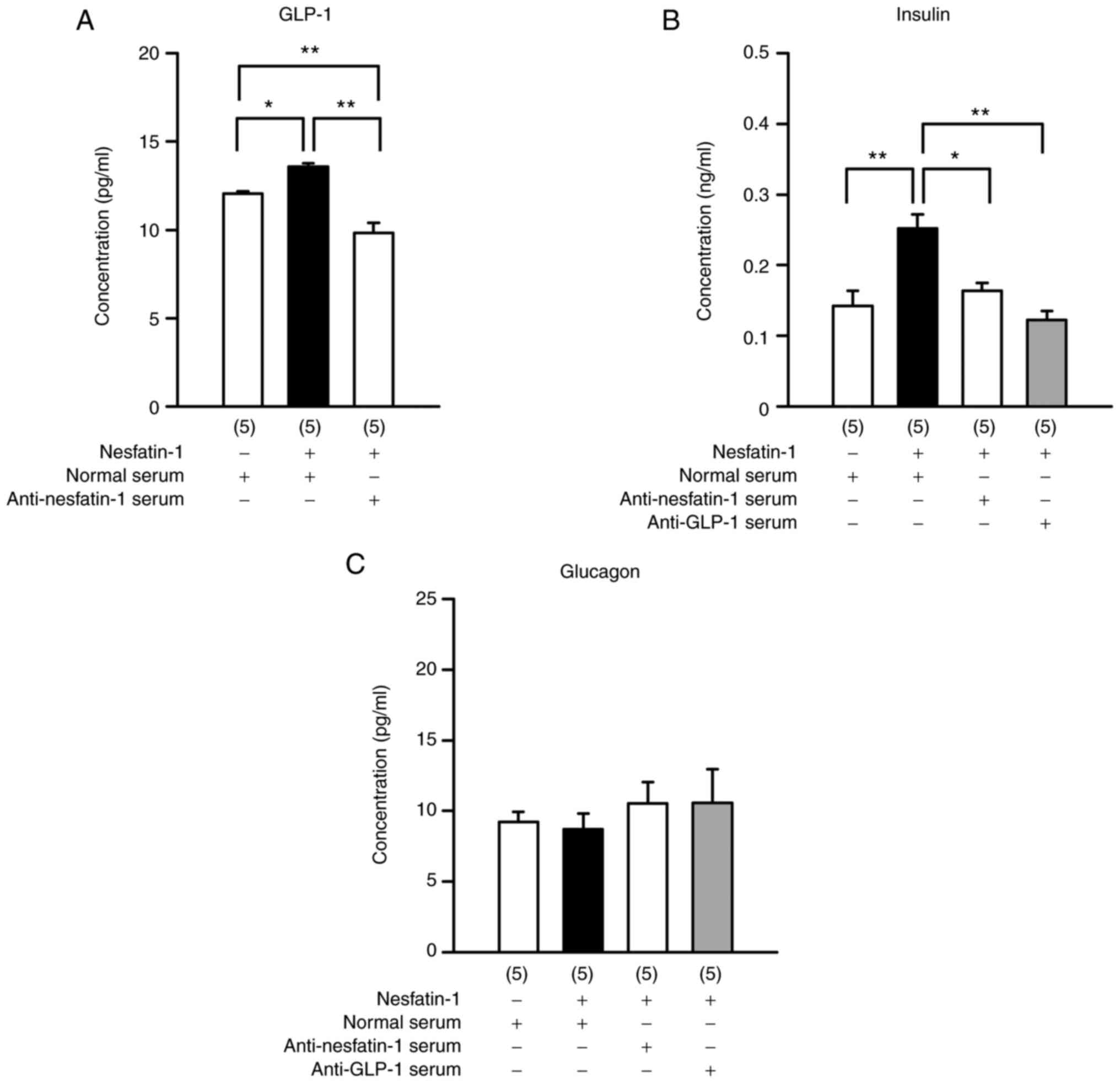|
1
|
Holst JJ, Gribble F, Horowitz M and Rayner
CK: Roles of the gut in glucose homeostasis. Diabetes Care.
39:884–892. 2016. View Article : Google Scholar : PubMed/NCBI
|
|
2
|
Galicia-Garcia U, Benito-Vicente A, Jebari
S, Larrea-Sebal A, Siddiqi H, Uribe KB, Ostolaza H and Martin C:
Pathophysiology of type 2 diabetes mellitus. Int J Mol Sci.
21:62752020. View Article : Google Scholar : PubMed/NCBI
|
|
3
|
Prentki M, Matschinsky FM and Madiraju SR:
Metabolic signaling in fuel-induced insulin secretion. Cell Metab.
18:162–185. 2013. View Article : Google Scholar : PubMed/NCBI
|
|
4
|
Nauck MA and Meier JJ: Incretin hormones:
Their role in health and disease. Diabetes Obes Metab. 20 (Suppl
1):S5–S21. 2018. View Article : Google Scholar : PubMed/NCBI
|
|
5
|
Oh-I S, Shimizu H, Satoh T, Okada S,
Adachi S, Inoue K, Eguchi H, Yamamoto M, Imaki T, Hashimoto K, et
al: Identification of nesfatin-1 as a satiety molecule in the
hypothalamus. Nature. 443:709–712. 2006. View Article : Google Scholar : PubMed/NCBI
|
|
6
|
Konczol K, Pinter O, Ferenczi S, Varga J,
Kovacs K, Palkovits M, Zelena D and Toth ZE: Nesfatin-1 exerts
long-term effect on food intake and body temperature. Int J Obes
(Lond). 36:1514–1521. 2012. View Article : Google Scholar : PubMed/NCBI
|
|
7
|
Gonzalez R, Tiwari A and Unniappan S:
Pancreatic beta cells colocalize insulin and pronesfatin
immunoreactivity in rodents. Biochem Biophys Res Commun.
381:643–648. 2009. View Article : Google Scholar : PubMed/NCBI
|
|
8
|
Ramanjaneya M, Chen J, Brown JE, Tripathi
G, Hallschmid M, Patel S, Kern W, Hillhouse EW, Lehnert H, Tan BK
and Randeva HS: Identification of nesfatin-1 in human and murine
adipose tissue: A novel depot-specific adipokine with increased
levels in obesity. Endocrinology. 151:3169–3180. 2010. View Article : Google Scholar : PubMed/NCBI
|
|
9
|
Stengel A, Goebel M, Yakubov I, Wang L,
Witcher D, Coskun T, Tache Y, Sachs G and Lambrecht NW:
Identification and characterization of nesfatin-1 immunoreactivity
in endocrine cell types of the rat gastric oxyntic mucosa.
Endocrinology. 150:232–238. 2009. View Article : Google Scholar : PubMed/NCBI
|
|
10
|
Osaki A, Shimizu H, Ishizuka N, Suzuki Y,
Mori M and Inoue S: Enhanced expression of nesfatin/nucleobindin-2
in white adipose tissue of ventromedial hypothalamus-lesioned rats.
Neurosci Lett. 521:46–51. 2012. View Article : Google Scholar : PubMed/NCBI
|
|
11
|
Zhang AQ, Li XL, Jiang CY, Lin L, Shi RH,
Chen JD and Oomura Y: Expression of nesfatin-1/NUCB2 in rodent
digestive system. World J Gastroenterol. 16:1735–1741. 2010.
View Article : Google Scholar : PubMed/NCBI
|
|
12
|
Yang M, Zhang Z, Wang C, Li K, Li S, Boden
G, Li L and Yang G: Nesfatin-1 action in the brain increases
insulin sensitivity through Akt/AMPK/TORC2 pathway in diet-induced
insulin resistance. Diabetes. 61:1959–1968. 2012. View Article : Google Scholar : PubMed/NCBI
|
|
13
|
Marraudino M, Bonaldo B, Farinetti A,
Panzica G, Ponti G and Gotti S: Metabolism disrupting chemicals and
alteration of neuroendocrine circuits controlling food intake and
energy metabolism. Front Endocrinol (Lausanne). 9:7662018.
View Article : Google Scholar : PubMed/NCBI
|
|
14
|
Drougard A, Fournel A, Valet P and Knauf
C: Impact of hypothalamic reactive oxygen species in the regulation
of energy metabolism and food intake. Front Neurosci. 9:562015.
View Article : Google Scholar : PubMed/NCBI
|
|
15
|
Stanley SA, Kelly L, Latcha KN, Schmidt
SF, Yu X, Nectow AR, Sauer J, Dyke JP, Dordick JS and Friedman JM:
Bidirectional electromagnetic control of the hypothalamus regulates
feeding and metabolism. Nature. 531:647–650. 2016. View Article : Google Scholar : PubMed/NCBI
|
|
16
|
Adriaenssens AE, Biggs EK, Darwish T,
Tadross J, Sukthankar T, Girish M, Polex-Wolf J, Lam BY, Zvetkova
I, Pan W, et al: Glucose-dependent insulinotropic polypeptide
receptor-expressing cells in the hypothalamus regulate food intake.
Cell Metab. 30:987–996. e62019. View Article : Google Scholar : PubMed/NCBI
|
|
17
|
Su Y, Zhang J, Tang Y, Bi F and Liu JN:
The novel function of nesfatin-1: Anti-hyperglycemia. Biochem
Biophys Res Commun. 391:1039–1042. 2010. View Article : Google Scholar : PubMed/NCBI
|
|
18
|
Gonzalez R, Perry RL, Gao X, Gaidhu MP,
Tsushima RG, Ceddia RB and Unniappan S: Nutrient responsive
nesfatin-1 regulates energy balance and induces glucose-stimulated
insulin secretion in rats. Endocrinology. 152:3628–3637. 2011.
View Article : Google Scholar : PubMed/NCBI
|
|
19
|
Li Z, Gao L, Tang H, Yin Y, Xiang X, Li Y,
Zhao J, Mulholland M and Zhang W: Peripheral effects of nesfatin-1
on glucose homeostasis. PLoS One. 8:e715132013. View Article : Google Scholar : PubMed/NCBI
|
|
20
|
Riva M, Nitert MD, Voss U, Sathanoori R,
Lindqvist A, Ling C and Wierup N: Nesfatin-1 stimulates glucagon
and insulin secretion and beta cell NUCB2 is reduced in human type
2 diabetic subjects. Cell Tissue Res. 346:393–405. 2011. View Article : Google Scholar : PubMed/NCBI
|
|
21
|
Li QC, Wang HY, Chen X, Guan HZ and Jiang
ZY: Fasting plasma levels of nesfatin-1 in patients with type 1 and
type 2 diabetes mellitus and the nutrient-related fluctuation of
nesfatin-1 level in normal humans. Regul Pept. 159:72–77. 2010.
View Article : Google Scholar : PubMed/NCBI
|
|
22
|
Zhang Z, Li L, Yang M, Liu H, Boden G and
Yang G: Increased plasma levels of nesfatin-1 in patients with
newly diagnosed type 2 diabetes mellitus. Exp Clin Endocrinol
Diabetes. 120:91–95. 2012. View Article : Google Scholar : PubMed/NCBI
|
|
23
|
Guo Y, Liao Y, Fang G, Dong J and Li Z:
Increased nucleobindin-2 (NUCB2) transcriptional activity links the
regulation of insulin sensitivity in type 2 diabetes mellitus. J
Endocrinol Invest. 36:883–888. 2013.PubMed/NCBI
|
|
24
|
Nakata M, Manaka K, Yamamoto S, Mori M and
Yada T: Nesfatin-1 enhances glucose-induced insulin secretion by
promoting Ca2+ influx through L-type channels in mouse
islet beta-cells. Endocr J. 58:305–313. 2011. View Article : Google Scholar : PubMed/NCBI
|
|
25
|
Maejima Y, Horita S, Kobayashi D, Aoki M,
O'Hashi R, Imai R, Sakamoto K, Mori M, Takasu K, Ogawa K, et al:
Nesfatin-1 inhibits voltage gated K+ channels in
pancreatic beta cells. Peptides. 95:10–15. 2017. View Article : Google Scholar : PubMed/NCBI
|
|
26
|
Ramesh N, Mortazavi S and Unniappan S:
Nesfatin-1 stimulates glucagon-like peptide-1 and glucose-dependent
insulinotropic polypeptide secretion from STC-1 cells in vitro.
Biochem Biophys Res Commun. 462:124–130. 2015. View Article : Google Scholar : PubMed/NCBI
|
|
27
|
Mizutani M, Atsuchi K, Asakawa A, Matsuda
N, Fujimura M, Inui A, Kato I and Fujimiya M: Localization of acyl
ghrelin- and des-acyl ghrelin-immunoreactive cells in the rat
stomach and their responses to intragastric pH. Am J Physiol
Gastrointest Liver Physiol. 297:G974–G980. 2009. View Article : Google Scholar : PubMed/NCBI
|
|
28
|
Schmittgen TD and Livak KJ: Analyzing
real-time PCR data by the comparative C(T) method. Nat Protoc.
3:1101–1108. 2008. View Article : Google Scholar : PubMed/NCBI
|
|
29
|
Shimizu H, Oh IS, Hashimoto K, Nakata M,
Yamamoto S, Yoshida N, Eguchi H, Kato I, Inoue K, Satoh T, et al:
Peripheral administration of nesfatin-1 reduces food intake in
mice: The leptin-independent mechanism. Endocrinology. 150:662–671.
2009. View Article : Google Scholar : PubMed/NCBI
|
|
30
|
Tekin T, Cicek B and Konyaligil N:
Regulatory peptide nesfatin-1 and its relationship with metabolic
syndrome. Eurasian J Med. 51:280–284. 2019. View Article : Google Scholar : PubMed/NCBI
|
|
31
|
Dumonteil E, Magnan C, Ritz-Laser B, Meda
P, Dussoix P, Gilbert M, Ktorza A and Philippe J: Insulin, but not
glucose lowering corrects the hyperglucagonemia and increased
proglucagon messenger ribonucleic acid levels observed in
insulinopenic diabetes. Endocrinology. 139:4540–4546. 1998.
View Article : Google Scholar : PubMed/NCBI
|
|
32
|
da Silva Xavier G, Farhan H, Kim H,
Caxaria S, Johnson P, Hughes S, Bugliani M, Marselli L, Marchetti
P, Birzele F, et al: Per-arnt-sim (PAS) domain-containing protein
kinase is downregulated in human islets in type 2 diabetes and
regulates glucagon secretion. Diabetologia. 54:819–827. 2011.
View Article : Google Scholar : PubMed/NCBI
|
|
33
|
Oben J, Morgan L, Fletcher J and Marks V:
Effect of the entero-pancreatic hormones, gastric inhibitory
polypeptide and glucagon-like polypeptide-1(7–36) amide, on fatty
acid synthesis in explants of rat adipose tissue. J Endocrinol.
130:267–272. 1991. View Article : Google Scholar : PubMed/NCBI
|
|
34
|
Orskov C, Wettergren A and Holst JJ:
Biological effects and metabolic rates of glucagonlike peptide-1
7–36 amide and glucagonlike peptide-1 7–37 in healthy subjects are
indistinguishable. Diabetes. 42:658–661. 1993. View Article : Google Scholar : PubMed/NCBI
|
|
35
|
Drucker DJ and Nauck MA: The incretin
system: Glucagon-like peptide-1 receptor agonists and dipeptidyl
peptidase-4 inhibitors in type 2 diabetes. Lancet. 368:1696–1705.
2006. View Article : Google Scholar : PubMed/NCBI
|
|
36
|
Aoki K, Kamiyama H, Yoshimura K, Shibuya
M, Masuda K and Terauchi Y: Miglitol administered before breakfast
increased plasma active glucagon-like peptide-1 (GLP-1) levels
after lunch in patients with type 2 diabetes treated with
sitagliptin. Acta Diabetol. 49:225–230. 2012. View Article : Google Scholar : PubMed/NCBI
|
|
37
|
Brunton SA and Wysham CH: GLP-1 receptor
agonists in the treatment of type 2 diabetes: role and clinical
experience to date. Postgrad Med. 132:3–14. 2020. View Article : Google Scholar : PubMed/NCBI
|
|
38
|
Ahren B: DPP-4 Inhibition and the path to
clinical proof. Front Endocrinol (Lausanne). 10:3762019. View Article : Google Scholar : PubMed/NCBI
|
|
39
|
Tolhurst G, Reimann F and Gribble FM:
Nutritional regulation of glucagon-like peptide-1 secretion. J
Physiol. 587:27–32. 2009. View Article : Google Scholar : PubMed/NCBI
|
|
40
|
Lan H, Lin HV, Wang CF, Wright MJ, Xu S,
Kang L, Juhl K, Hedrick JA and Kowalski TJ: Agonists at GPR119
mediate secretion of GLP-1 from mouse enteroendocrine cells through
glucose-independent pathways. Br J Pharmacol. 165:2799–2807. 2012.
View Article : Google Scholar : PubMed/NCBI
|
|
41
|
Iwasaki Y, Sendo M, Dezaki K, Hira T, Sato
T, Nakata M, Goswami C, Aok R, Arai T, Kumari P, et al: GLP-1
release and vagal afferent activation mediate the beneficial
metabolic and chronotherapeutic effects of D-allulose. Nat Commun.
9:1132018. View Article : Google Scholar : PubMed/NCBI
|
|
42
|
Feijoo-Bandin S, Rodriguez-Penas D,
Garcia-Rua V, Mosquera-Leal A, Otero MF, Pereira E, Rubio J,
Martinez I, Seoane LM, Gualillo O, et al: Nesfatin-1 in human and
murine cardiomyocytes: Synthesis, secretion and mobilization of
GLUT-4. Endocrinology. 154:4757–4767. 2013. View Article : Google Scholar : PubMed/NCBI
|
|
43
|
Wu D, Yang M, Chen Y, Jia Y, Ma ZA, Boden
G, Li L and Yang G: Hypothalamic nesfatin-1/NUCB2 knockdown
augments hepatic gluconeogenesis that is correlated with inhibition
of mTOR-STAT3 signaling pathway in rats. Diabetes. 63:1234–1247.
2014. View Article : Google Scholar : PubMed/NCBI
|
|
44
|
Tasatargil A, Kuscu N, Dalaklioglu S,
Adiguzel D, Celik-Ozenci C and Ozdem S, Barutcigil A and Ozdem S:
Cardioprotective effect of nesfatin-1 against isoproterenol-induced
myocardial infarction in rats: Role of the Akt/GSK-3beta pathway.
Peptides. 95:1–9. 2017. View Article : Google Scholar : PubMed/NCBI
|
|
45
|
Fan XT, Tian Z, Li SZ, Zhai T, Liu JL,
Wang R, Zhang CS, Wang LX, Yuan JH, Zhou Y and Dong J: Ghrelin
receptor is required for the effect of nesfatin-1 on glucose
metabolism. Front Endocrinol (Lausanne). 9:6332018. View Article : Google Scholar : PubMed/NCBI
|
|
46
|
Li T, Wei S, Fan C, Tang D and Luo D:
Nesfatin-1 promotes proliferation, migration and invasion of
HTR-8/SVneo trophoblast cells and inhibits oxidative stress via
activation of PI3K/AKT/mTOR and AKT/GSK3beta pathway. Reprod Sci.
28:550–561. 2021. View Article : Google Scholar : PubMed/NCBI
|
|
47
|
Su RY, Geng XY, Yang Y and Yin HS:
Nesfatin-1 inhibits myocardial ischaemia/reperfusion injury through
activating Akt/ERK pathway-dependent attenuation of endoplasmic
reticulum stress. J Cell Mol Med. 25:5050–5059. 2021. View Article : Google Scholar : PubMed/NCBI
|
|
48
|
Prinz P, Goebel-Stengel M, Teuffel P, Rose
M, Klapp BF and Stengel A: Peripheral and central localization of
the nesfatin-1 receptor using autoradiography in rats. Biochem
Biophys Res Commun. 470:521–527. 2016. View Article : Google Scholar : PubMed/NCBI
|
|
49
|
Rupp SK, Wolk E and Stengel A: Nesfatin-1
receptor: Distribution, signaling and increasing evidence for a G
protein-coupled receptor-A systematic review. Front Endocrinol.
12:7401742021. View Article : Google Scholar : PubMed/NCBI
|
|
50
|
Dong J, Xu H, Wang PF, Cai GJ, Song HF,
Wang CC, Dong ZT, Ju YJ and Jiang ZY: Nesfatin-1 stimulates
fatty-acid oxidation by activating AMP-activated protein kinase in
STZ-induced type 2 diabetic mice. PLoS One. 8:e833972013.
View Article : Google Scholar : PubMed/NCBI
|
|
51
|
Gabery S, Salinas CG, Paulsen SJ,
Ahnfelt-Ronne J, Alanentalo T, Baquero AF, Buckley ST, Farkas E,
Fekete C, Frederiksen KS, et al: Semaglutide lowers body weight in
rodents via distributed neural pathways. JCI insight.
5:e1334292020. View Article : Google Scholar : PubMed/NCBI
|















